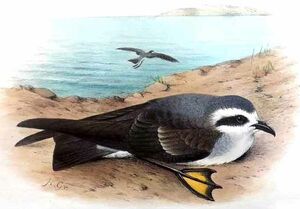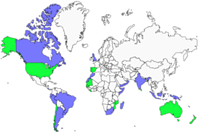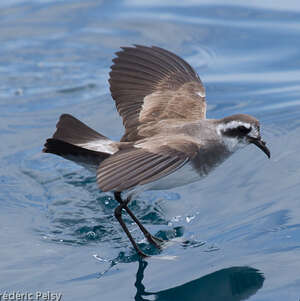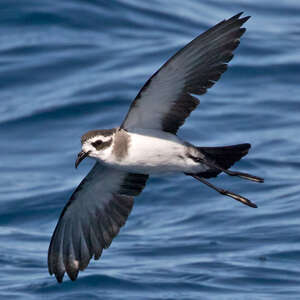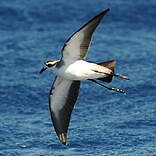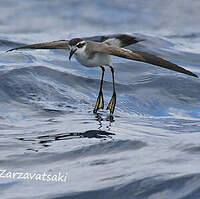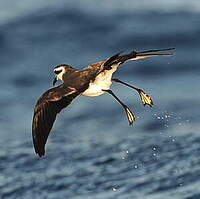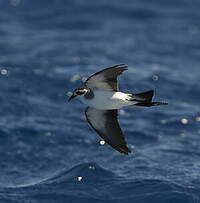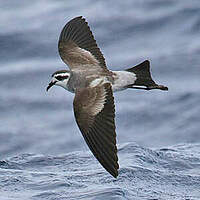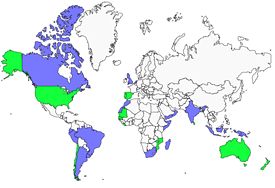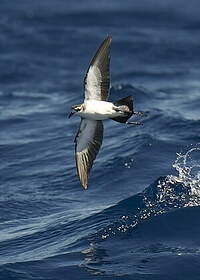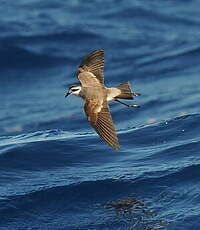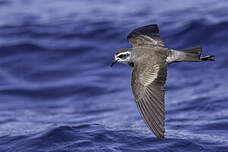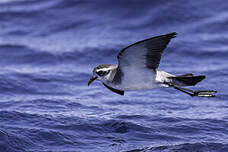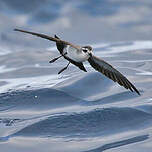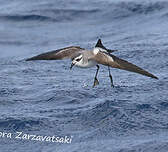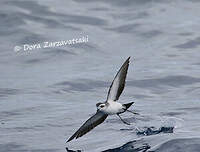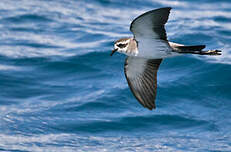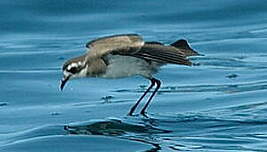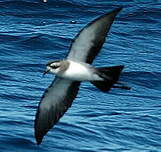White-faced Storm Petrel
Pelagodroma marina - Océanite frégate
Identification
The White-faced Storm Petrel does not pose any identification problems thanks to the combination of the design of its head and, above all, its very light underside and its long thin legs that extend beyond the tail while in flight.
Seen from beneath, the bird is light, practically white, only the primaries and rectrices, of a medium grey, are not, but from a distance, the underside really looks white. The head is contrasted with a crown and post-ocular line that is dark, separated by a clear white eyebrow that reaches the forehead, which is also white.
The upper side appears dark, with very dark primaries and rectrices, coverts of a slightly lighter grey, as is the rump; one can distinguish a narrow white band formed by the tips of the large coverts. The tail is cut straight, sometimes very slightly forked.
The beak, black, is slender.
This White-faced Storm Petrel could be mistaken for the White-throated Storm Petrel (Nesofregetta fuliginosa) which is considerably larger and the Hornby's Storm Petrel (Oceanodroma hornbyi) which has the underside of the wings completely dark.
Subspecific information 6 subspecies
- Pelagodroma marina marina (Tristan da Cunha amd Gough Is.)
- Pelagodroma marina hypoleuca (Madeira and Canary Is.)
- Pelagodroma marina eadesorum (Cape Verde Is.)
- Pelagodroma marina dulciae (islands off of s Australia)
- Pelagodroma marina maoriana (Stewart, Auckland, Chatham and other islands of New Zealand)
- Pelagodroma marina albiclunis (Kermadec Is.)
Foreign names
- Océanite frégate,
- Paíño pechialbo,
- calca-mar,
- Weißgesicht-Sturmschwalbe,
- fehérarcú viharfecske,
- Bont Stormvogeltje,
- Uccello delle tempeste facciabianca,
- fregattstormsvala,
- Fregattstormsvale,
- búrkozvest morský,
- buřníček běločelý,
- Fregatstormsvale,
- ulappakeiju,
- Witwangstormswael,
- ocell de tempesta carablanc,
- Njarðarsvala,
- oceannik białobrewy,
- baltsejas vētrasburātājs,
- progastoglavi strakoš,
- Белолицая качурка,
- Petrel-badai muka-putih,
- カオジロウミツバメ,
- 白脸海燕,
- 白臉海燕,
Habitat
Behaviour character trait
Dietfeeding habits
Reproduction nesting
White-faced Storm Petrels reach sexual maturity at about 3 years old. They dig burrows in the sandy soil, or occasionally in a rocky crevice. They lay one egg that is incubated for around 2 months, with both sexes taking turns every 3 to 5 days. The chicks are born covered with pale gray down and are sheltered by an adult for about 4 days after hatching. They stay in the nest for between 52 and 67 days before they can fly.
Geographic range
The White-faced Storm Petrel breeds in the Atlantic from the archipelago of Madeira to the North, to St Helena and Tristan da Cunha to the South. It also nests on many islands off the southern and western coasts of Australia and New Zealand. Outside of the breeding season, it can be spotted in the Pacific south of the equator, in tropical and/or temperate zones as well as in the Indian Ocean up to the coasts of the Arabian Peninsula. An observation done before 1949 outside of Madeira and the Canaries in the British Isles is a rare occurrence.
Threats - protection
IUCN conservation status
concern
in the Wild
threatened
evaluated
Overall, the species is not threatened (several millions of pairs). Nonetheless, some populations are, such as the ones of the Cape Verde Islands. This White-faced Storm Petrel is very sensitive to disturbances of any kind. Its main predators are rats, cats, as well as, in the sea, the great seagulls.
Sources of information
- IOC World Bird List (v14.1), Gill, F and D Donsker (Eds). 2024-04-18.
- Albatrosses, Petrels and Shearwaters of the World, Onley Derek et Scofield Paul
- Field Guide to New Zealand Seabirds, Parkinson Brian
- The Field Guide to the Birds of Australia, Graham Pizzey et Frank Knight
- Vol. 1 - Handbook of the Birds of the World, Josep del Hoyo-Andrew Elliot-Jordi Sargatal
- Avibase, Lepage Denis
Other sources of interest
 Specification sheet created on
30/07/2023 by Georges Olioso
Specification sheet created on
30/07/2023 by Georges OliosoTranslation by AI Oiseaux.net
published: 09-11-2012 - Updated: 02-12-2012
© 1996-2024 Oiseaux.net
- Accipitriformes
- Aegotheliformes
- Anseriformes
- Apodiformes
- Apterygiformes
- Bucerotiformes
- Caprimulgiformes
- Cariamiformes
- Casuariiformes
- Charadriiformes
- Ciconiiformes
- Coliiformes
- Columbiformes
- Coraciiformes
- Cuculiformes
- Eurypygiformes
- Falconiformes
- Galliformes
- Gaviiformes
- Gruiformes
- Leptosomiformes
- Mesitornithiformes
- Musophagiformes
- Nyctibiiformes
- Opisthocomiformes
- Otidiformes
- Passeriformes
- Pelecaniformes
- Phaethontiformes
- Phoenicopteriformes
- Piciformes
- Podargiformes
- Podicipediformes
- Procellariiformes
- Psittaciformes
- Pterocliformes
- Rheiformes
- Sphenisciformes
- Steatornithiformes
- Strigiformes
- Struthioniformes
- Suliformes
- Tinamiformes
- Trogoniformes

